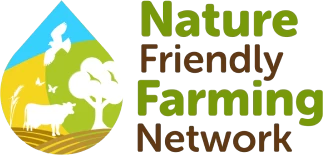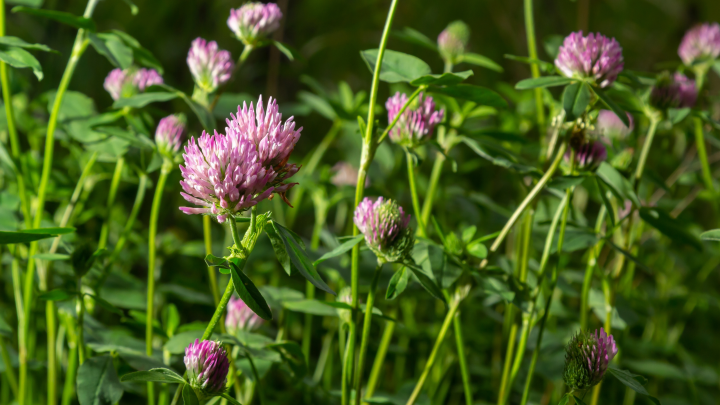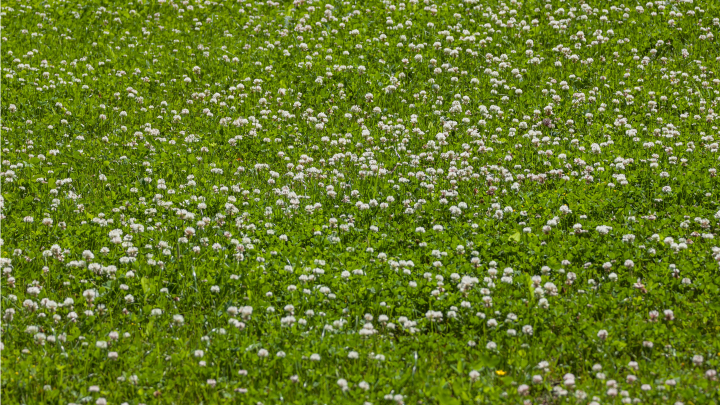Lower N applications resulting from N fixed by clover, reduce N leaching into water and greenhouse gas emissions. Less than 20% of N applied to the land in fertiliser is actually incorporated into agricultural products, with the rest leaching into groundwater, rivers, and lakes as nitrate and nitrite, or the atmosphere as N2 gas or nitrous oxide[6].
Nitrous oxide, N2O, is a potent greenhouse gas. For every 100kg N applied, 10kg of nitrous oxide is emitted[7]. By fixing N in root nodules, and therefore not having N present in a reactive form in the soil, clover can help reduce these emissions. Fossil fuels needed in the manufacture, transport, and application of fertiliser are also a source of CO2. For clover, the energy needed for N fixation comes from the sun via photosynthesis.
Clover can also improve soil structure in grasslands by increasing earthworm abundance and improved root development. Grass plus clover mixtures can also reduce weed invasion[8].
Which bees benefit from clover?
As honeybees are frequent visitors to white clover, its use may help counteract the decline of managed honeybee colonies in the UK, which have declined by 75% in the last century[9]. Clover- and legume-rich grasslands are also an important food source for bumblebees. Shorter-tongued bumblebee species tend to be more abundant on white clover, whereas longer-tongued species, which are of greater conservation concern in the UK, more frequently visit red clover.
Aside from honeybees and bumblebees, other bee species, of which there are c.240 additional species in Britain, are less frequent visitors to clover and legumes. Moreover, the long corolla tubes of clover flowers make the nectar inaccessible to the mouthparts of most hoverfly species.
A potential solution to this is planting multi-species swards to increase the range of pollinators which benefit. These seed mixes can include additional legumes such as sainfoin, vetches, and birds foot trefoil, and forbs such as chicory. Diverse grassland swards bring a variety of additional benefits including improved livestock performance, stability, drought resistance, and reduced weed invasion.
In the context of the University of Sussex’s research experience, many farmers were not aware that one of the benefits of clover was to bees and insects. Given the high cost of N fertiliser, using clover can be a low-cost way to sustain agricultural productivity, reduce environmental impact, and improve the food supply for bees. Increasing the use of clover can therefore produce a ‘win-win-win’ for farmers, the environment, and bees, and can be an important part of a wider transition towards nature-friendly farming.
References
Timberlake TP, Vaughan IP, Memmott J (2019) Phenology of farmland floral resources reveals seasonal gaps in nectar availability for bumblebees. J Appl Ecol 56:1585–1596. https:// doi. org/ 10. 1111/ 1365- 2664. 13403
Harris, C., Ratnieks, F.L.W., 2021. Clover in agriculture: combined benefits for bees, environment, and farmer. J. Insect Conserv. 1–19. https://doi.org/10.1007/s10841-021-00358-z
Andrews M, Scholefield D, Abberton MT et al (2007) Use of white clover as an alternative to nitrogen fertiliser for dairy pastures in nitrate vulnerable zones in the UK: productivity, environmental impact and economic considerations. Ann Appl Biol 151:11–23. https:// doi. org/ 10. 1111/j. 1744- 7348. 2007. 00137.x
Stopes C, Millington S, Woodward L (1996) Dry matter and nitrogen accumulation by three leguminous green manure species and the yield of a following wheat crop in an organic production system. Agric Ecosyst Environ 57:189–196. https:// doi. org/ 10. 1016/ 0167- 8809(95) 01002-5
Doel JM (2013) Accumulation and recovery of nitrogen in mixed farming systems using legumes and other fertility-building crops
Jarvis SC (1993) Nitrogen cycling and losses from dairy farms. Soil Use Manag 9:99–104. https:// doi. org/ 10. 1111/j. 1475- 2743. 1993. tb009 37.x
IPCC (2006) 2006 IPCC Guidelines for national greenhouse gas inven- tories, national greenhouse gas inventories programme. https:// www. ipccn ggip. iges. or. jp/ public/ 2006gl/ index. html.
de Haas BR, Hoekstra NJ, van der Schoot JR et al (2019) Combining agro-ecological functions in grass-clover mixtures. AIMS Agric Food 4:547–567. https:// doi. org/ 10. 3934/ agrfood. 2019.3. 547
Balfour, N.J., Ollerton, J., Castellanos, M.C., Ratnieks, F.L.W., 2018. British phenological records indicate high diversity and extinction rates among late-summer-flying pollinators. Biol. Conserv. 222, 278–283. https://doi.org/10.1016/j.biocon.2018.04.028
Neumann P, Carreck NL (2010) Honey bee colony losses. J Apic Res 49:1–6. https:// doi. org/ 10. 3896/ IBRA.1. 49.1. 01




